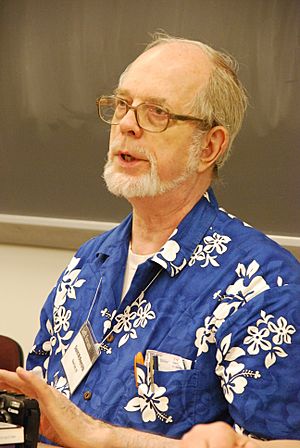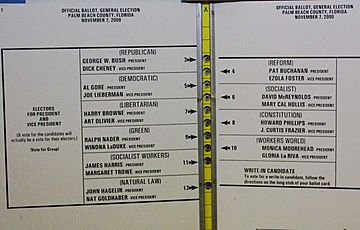David McReynolds facts for kids
Quick facts for kids
David McReynolds
|
|
|---|---|

McReynolds at the 2009 Left Forum in New York City
|
|
| Personal details | |
| Born |
David Ernest McReynolds
October 25, 1929 Los Angeles, California |
| Died | August 17, 2018 (aged 88) New York, New York |
| Political party | Independent (2015-2018) |
| Other political affiliations |
Socialist Party (1951–2015) Prohibition Party (before 1951) Green (affiliated non-member) |
| Alma mater | University of California Los Angeles |
| Occupation | Activist, politician, writer |
David Ernest McReynolds (October 25, 1929 – August 17, 2018) was an American politician and social activist. He was known for being a democratic socialist and a pacifist activist. He worked for 40 years with the War Resisters League, a group that promotes peace. McReynolds lived in New York City. He ran for President of the United States twice, representing the Socialist Party USA in 1980 and 2000.
Contents
David McReynolds' Early Life and Education
David Ernest McReynolds was born in Los Angeles, California. His mother, Elizabeth Grace (Tallon), was a nurse. His father, Lt. Col. Charles McReynolds, was an Air Force intelligence officer.
From 1957 to 1960, he worked for Liberation, a magazine focused on left-wing ideas.
McReynolds joined the Prohibition Party around 1946 or 1947. He grew up as a fundamentalist Baptist. He later left the party when it removed its youth section.
He became more interested in left-wing ideas and joined the Socialist Party of America in 1951. In 1949, he became a pacifist, meaning he believed in peaceful solutions to problems.
He attended the University of California, Los Angeles (UCLA). He graduated in 1953. During his time at UCLA, he refused to serve in the Korean War. He was elected to the National Committee of the Socialist Party in 1954.
Working for Peace: The War Resisters League
McReynolds strongly believed in being anti-war. He was a draft resister, meaning he opposed being forced to join the military. In 1960, he started working for the War Resisters League (WRL). He stayed there until he retired in 1999.
In 1965, he gave a speech at the Free University of New York. He talked about older and newer political movements.
On November 6, 1965, McReynolds was one of five men who publicly burned their draft cards. This happened at an anti-war protest in New York. This was one of the first public acts of burning draft cards after a new law made it a serious offense.
He was good friends with Bayard Rustin, another important peace activist. He also knew famous writers like Quentin Crisp.
In 1968, he signed a pledge to refuse to pay taxes. This was a protest against the Vietnam War. He later supported the War Tax Resistance project. This group encouraged people to resist paying taxes as a way to protest war.
McReynolds was very active in international peace efforts. He was chairperson of War Resisters' International from 1986 to 1988. He also worked with the International Confederation for Disarmament and Peace. This group later joined the International Peace Bureau.
His Role in the Socialist Party USA
The Socialist Party of America (SPA) changed its name to the Social Democrats USA in 1972. Some members, including McReynolds, formed a new group called the Socialist Party USA (SPUSA). This new party was more left-wing. McReynolds was a member of both the SPUSA and another group called the Democratic Socialists of America (DSA).
McReynolds believed in combining a pacifist view with socialist economics. This meant he wanted a peaceful world and a fairer way to share wealth. He was against authoritarian rule. He worked with many different groups on the democratic left.
His pamphlet, The Philosophy of Nonviolence, shared his ideas. It showed how he thought about the challenges faced by political groups in the 20th century. He believed that a mix of pacifism and socialism could create a free and democratic society.
In his political career, McReynolds ran for Congress twice. He also ran for President twice. In 1958, he ran for Congress as a write-in candidate. In 1968, he ran for Congress again with the Peace and Freedom Party. He received 4.7% of the votes.
In the 1980 presidential election, the Socialist Party chose McReynolds as their candidate. Diane Drufenbrock was his running mate for Vice President. They were on the ballot in ten states. Their goal was to get more people to join the party.
He was nominated again for president in the 2000 election. After the 2000 election, some people thought that a confusing "butterfly ballot" in Florida caused many voters to make mistakes. They believed this might have affected the election results.
In 2015, McReynolds left the SPUSA.
2004 Senate Campaign
On July 10, 2004, McReynolds announced he would run for the Senate in New York. He ran on the Green Party ticket. His campaign was against the war. He ran against Chuck Schumer and received 36,942 votes.
Later Life and Legacy
McReynolds remained active in politics until shortly before his death. He attended meetings, spoke in classrooms, and participated in peace and anti-war events. His last arrest was in 2015. This was at a protest calling for an end to nuclear weapons.
He was also a passionate photographer throughout his life. In his last three years, he organized his collection of over 50,000 photos.
In 2015, McReynolds supported U.S. Senator Bernie Sanders for President of the United States. He called Sanders a "serious candidate."
David McReynolds passed away on August 17, 2018, at the age of 88. He died after a fall at his home in New York City.
See also
- List of peace activists
Works
- We Have Been Invaded by the 21st Century. Praeger, 1970.
- "Thinking About Retirement," Nonviolent Activist, March–April 1999.
- "Queer Reflections," New Politics, Vol 12, no. 1 (2008).
- "David McReynolds Photography"


